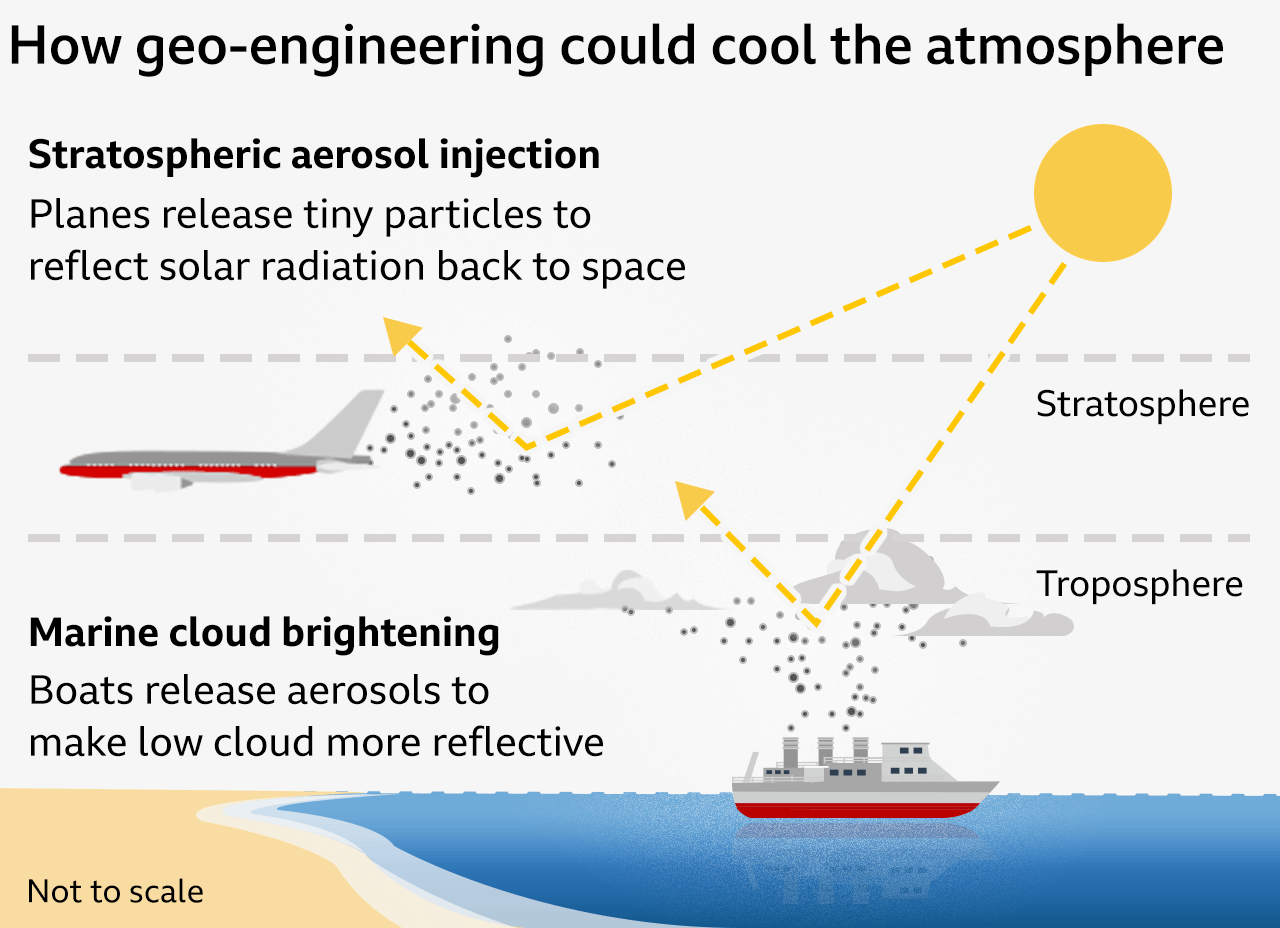
If we can’t control rising global temperatures by drastically cutting carbon emissions, could something called geo-engineering be a way to cool the planet?
In what is already a multi-billion-dollar industry, scientists around the world, including in the UK, are researching geo-engineering - ways of manipulating the climate to tackle global warming.
Some experts are concerned there are too many risks associated with it, fearing it could mess with global weather patterns or actually warm some regions, not cool them.
As the industry grows, so have conspiracy theories. BBC Weather has seen a large increase in social media comments around geo-engineering since January, accusing us of covering up secret projects and wrongly blaming geo-engineering for the cool and wet weather we’ve recently had. Worldwide, there have been twice as many mentions of geo-engineering this year on X, formerly known as Twitter, than over the last six months of 2023.
Some geo-engineering ideas include reflecting sunlight back out to space to cool Earth. The most advanced area of geo-engineering is direct air carbon capture with small-scale facilities in operation across Europe, the US and Canada. These currently remove around 10,000 tonnes of carbon dioxide a year, meaning it would need massively scaling up to make any difference to the roughly 35 billion tonnes we emit globally.
“We need to start to think about other things that we can do in order to limit any further warming,” says Professor Liz Bentley, chief executive of the Royal Meteorological Society. “That’s where geo-engineering starts to become an interesting discussion.”
Aside from fears about exacerbating the effects of climate change, some experts are worried it’s tempting to see geo-engineering as a quick fix that could also distract us from efforts to reduce carbon emissions.
Less weird than it seems
It sounds like the stuff of science fiction, but the idea of reflecting solar radiation, the technical term for sunlight, is not as crazy as it might sound and sometimes happens in the natural world. During volcanic eruptions, huge amounts of ash and aerosols - tiny particles - can be transported into the high atmosphere which can then reflect solar radiation back into space.

When Mount Pinatubo exploded in 1991 it cooled global temperatures
The eruption of Mount Pinatubo in the Philippines in 1991 led to the average global temperature cooling by 0.5C over the following couple of years.
So, could we really replicate a volcano to cool our planet?
Professor Jim Haywood, an atmospheric scientist at the University of Exeter, urges caution. “I really want to know about the detrimental impacts of climate change, but also about the potential side-effects and detrimental impacts of any solar radiation management deployments,” he said.

Researchers are studying two kinds of solar radiation management: marine cloud brightening and stratospheric aerosol injection.
Marine cloud brightening involves spraying very fine saltwater from a boat towards low-level clouds above the ocean to enhance their brightness and reflectivity.
Modelling has shown that if you were to spray a large area - around 4% of the ocean - near the equator and brighten clouds, the combination of more cloud and consequently a lower sea surface temperature beneath it could have worldwide impacts.
Our atmosphere is complex, has no borders and behaves like a fluid. You may have come across the ‘butterfly effect’ where if a butterfly were to flutter its wings in Mexico, it can bring rain to the UK. While in reality that is a big leap, it highlights how weather is connected all over the world.
“Brightening the cloud off the coast of Namibia could induce drought over South America and particularly Brazil. What's in Brazil? Well, the rainforests,” Prof Haywood said.
In this instance, because of complex atmospheric and ocean circulations, increasing the cloud brightness would cool the sea surface in the eastern south Atlantic, which means the rainfall pattern would be negatively disrupted across the south Atlantic towards South America. Drought in the Amazon rainforest - often referred to as the ‘lungs of the planet’ as they absorb carbon dioxide - could cause considerable damage.
While there is focus on using marine cloud brightening to offset global temperature rise, some see an opportunity to use it on a much smaller scale.
After a mass coral bleaching event in 2016 in the Great Barrier Reef, scientists at Southern Cross University in Australia have been conducting cloud brightening trials to shield and cool the very coral-rich areas of the reef to prevent bleaching during marine heatwaves.

Clouds have been spayed in an attempt to protect the Great Barrier Reef
“While we are in the early stages in understanding how marine cloud brightening might be applied over the Great Barrier Reef, we have made major scientific advancements.
"We have greatly increased our confidence that clouds over the reef can be brightened,” Professor Daniel Harrison, the project lead from Southern Cross University said.
Stratospheric tech development
The technology to perform marine cloud brightening on a small scale with fans and sprayers already exists, but the other method of solar radiation management - stratospheric aerosol injection - would need greater advances to have the desired impact.
This method of geo-engineering involves artificially adding aerosols such as sulphate into the stratosphere, which extends from 6-12 miles (10-20km) to 31 miles (50km) above the Earth. These aerosols would reflect some solar radiation, reducing the amount reaching our planet’s surface and theoretically cause a global cooling.

The Great Barrier Reef has suffered catastrophic bleaching
How enough aerosol could be injected into the stratosphere is uncertain but planes capable of flying at an altitude of 11 miles (18km) - around 1.5 times higher than commercial aircraft can - are one suggestion.
Millions of tonnes of sulphur dioxide would need to be injected to have any impact. For example, during the eruption of Mt. Pinatubo, the resulting half a degree of global cooling was the result of about 15 million tonnes of sulphur dioxide injected into the stratosphere.
Because sulphate aerosols only last a couple of years in the atmosphere compared to the decades that carbon dioxide lasts, stratospheric aerosol injection is only seen as a short-term method.
This hasn’t stopped one company in the US from starting to sell ‘cooling credits’. For a fee they will send a balloon filled with sulphur dioxide into the stratosphere, where it will burst and release the gas.
They suggest that one of their cooling credits - two grams of sulphur dioxide - will “offset one tonne of carbon dioxide warming for one year”. That’s the equivalent of one passenger’s return flight between Paris and New York, which means a lot of balloons would need to be released for this to have any sort of cooling effect.
As with marine cloud brightening, there are also risks with stratospheric aerosol injection. In a study earlier this year, computer modelling found that stratospheric aerosol injection could cause strong warming 15km above the tropics which would change large-scale weather patterns, warming the polar regions and altering rainfall patterns over land.
“The regional impacts are very much unknown,” Prof Bentley said. ”We may be able to mitigate global average temperature [rise], but we may actually make things worse in certain regions of the world”.
Hazard warnings
This brings us to fundamental questions about the credibility and risks involved in this kind of intervention. In 2022, hundreds of scientists signed an open letter calling for a global non-use agreement on solar radiation management.
They said increasing calls for development provided “cause for concern” with the dangers involved “poorly understood” and something that would act as a disincentive to governments, businesses and societies from decarbonising.
The group worries that even doing theoretical research will lead to real-world experiments without fully knowing the downsides. But other scientists think the risk of investigating solar radiation management further is smaller than the risk of relying solely on decarbonisation.
Additionally, some say that misinformation and conspiracists are preventing them from doing research.
Dr Ramit Debnath, an assistant professor at the University of Cambridge, says “a lot of funders are very sceptical of funding research” because they are wary of being targeted by conspiracists. He has analysed almost 2 million tweets with the hashtag #GeoEngineering and found that over 70% expressed negative sentiments about solar radiation management with the majority tapping into conspiracies.

Contrails are known as 'chemtrails' by some conspiracists
One of these is to do with ‘chemtrails’, a widely debunked conspiracy theory about an alleged secret plot to spray people with dangerous chemicals, suggesting the white streaks in the sky that come out the back of planes is evidence of this. These are actually condensed water vapour trails - known as contrails - that come from the jet engines of planes.
Contrails at this height actually absorb solar radiation and warm the planet and are therefore nothing to do with geo-engineering techniques currently being explored.
Dr Debnath says that by so much as talking about solar radiation management on social media, he is accused of “trying to kill people and control people’s lives”.
Solar radiation management is being treated with caution - the UK government hasn’t deployed the techniques and has “no plans to do so”. However, they are investing.
The Natural Environment Research Council has invited applications for a £10.5m fund in order to “deliver ‘risk-risk analyses’” to assess whether the negative impacts of the technique are greater than the damage that would be caused by climate change.
“It isn’t a silver bullet that’s going to solve everything,” said Prof Bentley. “But it possibly could be part of an array of solutions.”
Update: An earlier version of this article reported that 10,000 tonnes of carbon dioxide represented one third of London's annual emissions. This has now been amended. The current value of the geo-engineering industry has also been amended.
Get in touch
InDepth is the home for the best analysis from across BBC News. Tell us what you think.
BBC InDepth is the new home on the website and app for the best analysis and expertise from our top journalists. Under a distinctive new brand, we’ll bring you fresh perspectives that challenge assumptions, and deep reporting on the biggest issues to help you make sense of a complex world. And we’ll be showcasing thought-provoking content from across BBC Sounds and iPlayer too. We’re starting small but thinking big, and we want to know what you think - you can send us your feedback by clicking on the button below.

